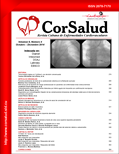Diagnosis, by Doppler echocardiography, of early complications in radial approach for percutaneous coronary intervention
Abstract
Introduction: Interventional procedures can be performed by multiple access routes such as: femoral, brachial, ulnar and radial access. The latter is an acceptable and safe alternative. However, no evaluation of the integrity of the radial artery is performed after the procedure.Objective: To determine, by Doppler echocardiography, the damage of the radial artery after an interventional procedure.
Method: Observational, descriptive, prospective and longitudinal study of 111 patients who underwent transradial interventional procedures, from July 2009 to September 2010, and underwent Doppler echocardiography of the radial artery in the first 72
hours after the procedure.
Results: There was a predominance of male patients aged from 55 to 64 years (45.9%), 24 patients (21.6%) had complications that were detected by Doppler echocardiography, of which 9 patients (8.1%) showed vascular lesions. Radial artery stenosis was
the most common lesion (5.4%). Hypertension (33.4%), diabetes mellitus (29.4%), a procedural time between 25-30 minutes (58.3%), and the age group between 45-54 years were predisposing factors for the occurrence of vascular complications (77.8%) and those related to the puncture site (54.1%).
Conclusions: The use of the radial approach is a safe option for percutaneous coronary intervention, which causes, in a low percentage, the occurrence of vascular complications and complications related to the puncture site.
Downloads
Download data is not yet available.
Downloads
Published
2014-10-07
How to Cite
1.
Rivero Seriel L, García Hernández RA, Mesa García F. Diagnosis, by Doppler echocardiography, of early complications in radial approach for percutaneous coronary intervention. CorSalud [Internet]. 2014 Oct. 7 [cited 2025 Nov. 8];6(4):308-13. Available from: https://revcorsalud.sld.cu/index.php/cors/article/view/118
Issue
Section
ORIGINAL ARTICLES
License
Authors who publish with this journal agree to the following terms:- Authors retain copyright and grant the journal right of first publication with the work simultaneously licensed under a Creative Commons Attribution License that allows others to share the work with an acknowledgement of the work's authorship and initial publication in this journal.
- Authors are able to enter into separate, additional contractual arrangements for the non-exclusive distribution of the journal's published version of the work (e.g., post it to an institutional repository or publish it in a book), with an acknowledgement of its initial publication in this journal.










